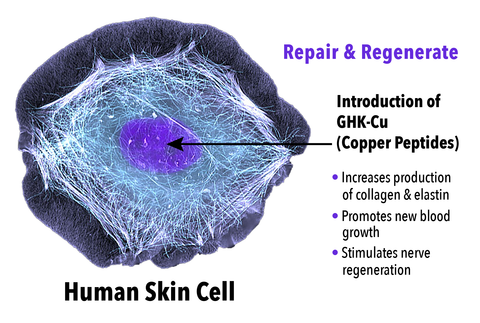
Some of the most common signs of aging include fine lines and wrinkles around the eyes (crow's feet) and mouth (laugh lines) in the mid-to-late 20s or early 30s. They are caused by decreased collagen and elastin production, the proteins that give skin structure and elasticity.
The loss of collagen and fat also leads to a loss of volume in the face, making the cheeks appear sunken, the jawline less defined, and the lips thinner.
As we age, our skin loses its ability to retain moisture, making it appear drier and less plump. One of the reasons is the decrease in keratin production, a protein in the outermost layer of the epidermis. This decrease can also lead to thinner and more fragile skin and a loss of skin tone, making the face appear saggy.
A tri-peptide, GHK-Cu, naturally present in your body, helps keep your skin firm, smooth and hydrated. Unfortunately, the levels of GHK-Cu decline with age. To put things into perspective, someone 20 would have approximately 200ng/mL of GHK. At 60 years of age, this amount goes down to 80 ng/ML. This represents a 60% decrease in GHK levels from age 20-60. As a result, our skin loses its firmness and elasticity.
Thankfully, Vitali's innovative skincare formulas incorporating GHK-Cu (Copper Peptides) can help bridge the gap. By mimicking the action of natural GHK-Cu, these formulas stimulate collagen, elastin, and keratin synthesis, smoothing wrinkles and plumping the skin, effectively turning back the clock on your skin's health. Regularly using these innovative formulas can keep skin looking better despite aging and environmental damage.
Vitali Skincare is formulated with natural and organic ingredients; Formulated without Parabens, Phthalates and free of fragrance and artificial color.
The most basic explanation is that GHK-Cu (Copper Peptide) causes rejuvenation by telling the body what to do. To quote Vitali's Medical Advisor, Dr. Suzanne Feree, "As far as skin goes, GHK-Cu tells your skin fibroblast, the STEM Cells of the skin, to repair and regenerate as if they were younger cells. We're talking about every single tissue where this molecule is used; it is able to repair and regenerate a more youthful expression of the cell."

Multiple studies show that this peptide not only improves the look of skin on a superficial level but also improves how the body behaves towards the skin and increases the skin's overall health.
The Research
Several placebo-controlled clinical studies found GHK-Cu to improve skin quality in women around 50. A survey of collagen production determined by studying skin biopsy samples using immunobiological techniques found that after applying creams to the thighs for one month, GHK-peptides significantly affected collagen production. Increases were seen in 70% of the women treated with GHK-Cu, in contrast to 50% treated with the vitamin C cream and 40% treated with retinoic acid.
A GHK-Cu facial cream reduced visible signs of aging after 12 weeks of application to the facial skin of 71 women with mild to advanced signs of photoaging. The cream improved skin laxity, clarity, and appearance, reduced fine lines and the depth of wrinkles, and increased skin density and thickness.
A GHK-Cu eye cream, tested on 41 women for twelve weeks with mild to advanced photodamage, was compared to a placebo control and an eye cream containing vitamin K. The GHK-Cu cream performed better than both controls in reducing lines and wrinkles, improving overall appearance, and increasing skin density and thickness.
In another 12-week facial study of 67 women between 50 and 59 years with mild to advanced photodamage, a GHK-Cu cream was applied twice daily and improved skin laxity, clarity, firmness, and appearance, reduced fine lines, coarse wrinkles, and mottled pigmentation, and increased skin density, and thickness. The cream also strongly stimulated dermal keratinocyte proliferation as determined by the histological analysis of biopsies.
Restart your body's natural rejuvenation process with Vitali's beautiful blue Copper Peptide Skincare products.
